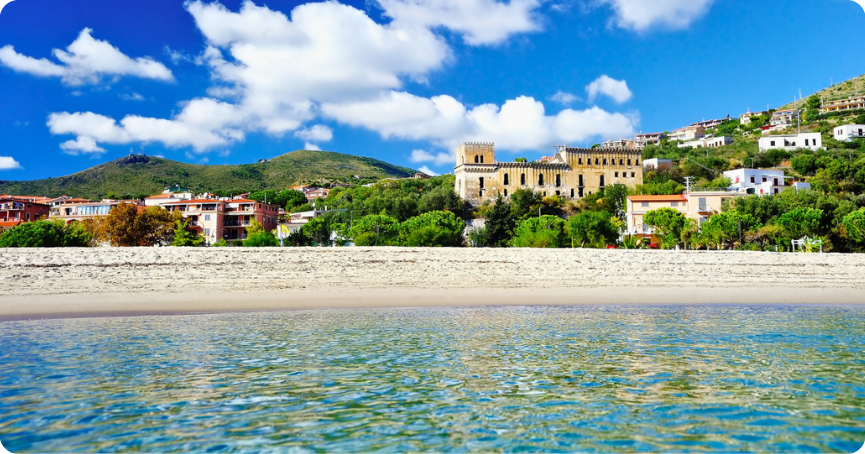With its rugged coastline carved by natural caves and hidden bays, the Cilento region offers a wealth of emotions to those who reach it by sea. A land of myths and the stage of ancient stories, it invites visitors to explore its archaeological, historical, and architectural treasures. Alongside its inland riches—villages, castles, and monasteries—the Cilento boasts an unparalleled natural heritage of breathtaking landscapes protected by the Cilento, Vallo di Diano, and Alburni National Park, Italy’s second-largest. Stretching to the Basilicata border, the Cilento Coast extends far beyond where our last article on the region left off.
Having reached Palinuro, we now embark southward, stopping at some of the southernmost towns on the Policastro Coast, which, while technically part of Campania, also touches the provinces of Potenza in Basilicata and Cosenza in Calabria. Our journey will culminate in Sapri, just a few kilometers from the Lucanian border, with stops at Scario—famed for some of Cilento’s most beautiful beaches—and Marina di Camerota.
Marina di Camerota: A Beach for Every Taste
The seaside district of Camerota, an ancient village perched on Mount Bulgheria, Marina di Camerota is flanked by crystal-clear waters on one side and lush green hills on the other. Its small port offers mooring with access to water, electricity, and fuel, surrounded by stunning scenery of coves, deep blue seas, and an alternating landscape of rocks, beaches, shrubs, and olive trees.
Renowned for its pristine waters, which have earned it the Blue Flag title for years, Marina di Camerota is a major tourist hub attracting large crowds annually. But its popularity need not deter visitors—those arriving by sea have the advantage of accessing its waters far from the land-based crowds. For those seeking seclusion, there are untouched beaches, perfect for those willing to trade comfort for immersion in nature’s beauty.
For those who prefer convenience, Calanca Beach offers a splendid, equipped option. Close to the town, it is tucked between two high, green-clad rocky cliffs that protect the relaxation of families drawn to its soft, light sands and shallow, sloping waters. From here, swimmers or walkers can also reach karst caves dotting the area, such as the beautiful Grotta dell’Acqua Dolce.Heading south along the coast is Lentiscelle Beach. Less suitable for children due to its deep waters, this beach features a mixed sand and pebble shore with both free and equipped areas. Nearly half a kilometer long, it is surrounded by the Mediterranean scrub typical of the Sentiero degli Infreschi. This trail begins at Lentiscelle Beach and passes stunning beaches like Pozzallo Beach, Cala Bianca—accessible only by sea—and the Baia degli Infreschi, nestled in a nature reserve between Marina di Camerota and Scario.
Scario: A Picture-Perfect Setting
Just 7 nautical miles from Marina di Camerota, Scario is a gem cherished for its unique location and mild climate. Approaching by sea, visitors are greeted by a postcard-perfect view: a quaint port, pastel-colored houses, palm trees, a church, and lush greenery.
As the main district of San Giovanni a Piro, Scario is a sought-after destination not only for its setting but also for its pristine, crystal-clear waters, teeming with marine flora and fauna. This richness is attributed to the karstic nature of the surrounding rocks, which bring cool freshwater springs to the seabed.
Sapri: The Final Stop of Sand and Rock
The last stop on our sea and land itinerary is Sapri, the southernmost town on the Cilento Coast. Along with Agropoli, it is one of the only municipalities in the area situated directly on the coast. Overlooking the Tyrrhenian Sea, Sapri lies in the southernmost part of Campania, bordering Lucania. With a history dating back to ancient times, it was known to the Greeks and later used by the Romans as a vacation spot.
After docking at its modern, well-equipped port, visitors can explore the town’s charming historic core. Following the promenade and its adjoining narrow streets leads to the Marinella, the 17th-century fishermen’s village now incorporated into the town’s old center.
Returning to the sea, Sapri’s town beach stretches for about a kilometer along the edge of the inhabited area, alternating between equipped sections and free zones. Predictably busy, it is easily accessible via a pleasant walk along the promenade. For panoramic views of the gulf and more tranquility, head north to Cammarelle Beach and the nearby Torre Specola.
For those who enjoy walking, the southern coast offers the ancient mule track curiously named Apprezzami l’Asino (Literally, “Value My Donkey”). This spectacular 3-kilometer path clings to the cliffs, offering breathtaking views along the narrow trail that once linked Sapri to Maratea.
Unlike the sandy beaches to the north, the southern coastline alternates between sand and rocky stretches. One standout is Torre di Capobianco Beach, an irregular stretch of coast named after one of the 16th-century watchtowers built by the Kingdom of Naples.
This final stretch of the Cilento Coast, from Camerota to Sapri, is a journey through natural splendor, historical charm, and unforgettable seaside vistas.

